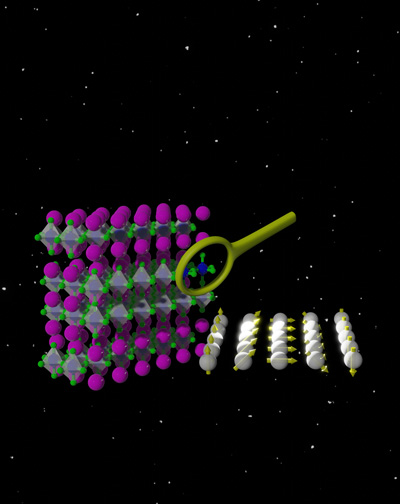Sep 21 2020
As humans’ lives get more and more intertwined with technology, whether promoting communication while streaming their favorite show or working remotely,so does their reliance on the data created by these devices.
 A crystal structure (left) and a visual model of the spin helix (right). Image Credit: Northwestern University.
A crystal structure (left) and a visual model of the spin helix (right). Image Credit: Northwestern University.
Data centers that support such technology ecosystems generate a considerable carbon footprint and consume 200 TW hours of energy annually. This is greater than the yearly energy consumption of Iran.
Therefore, to offset these ecological concerns and still fulfill the rising demand, advancements in microelectronic processors — the mainstay of several Internet of Things (IoT) devices and data hubs — should be eco-friendly and efficient.
Materials scientists from Northwestern University have now created new design principles that could help drive the growth of upcoming quantum materials used to improve various resource-intensive technologies, including IoT devices, while restricting ecological damage.
New path-breaking materials and computing paradigms are required to make data centers more energy-lean in the future.
James Rondinelli, Study Lead and Professor of Materials Science and Engineering, Northwestern University
Rondinelli is also the Morris E. Fine Professor in Materials and Manufacturing at the McCormick School of Engineering.
The research marks a major step in Rondinelli’s attempts to develop novel materials that are energy-efficient, non-volatile, and produce less heat— significant aspects of upcoming ultrafast, low-power quantum computers and electronics that can help fulfill the world’s growing demand for data.
Spin-Based Materials
Certain groups of semiconductors use the electron’s charge in transistors to fuel computing, but solid-state spin-based materials use the electron’s spin and are capable of supporting low-energy memory devices.
Specifically, materials that have a high-quality persistent spin texture (PST) can display a long-lived persistent spin helix (PSH), which can be used for monitoring or controlling the spin-based data in a transistor.
While several spin-based materials already encode data using spins, that information might be corrupted because the spins tend to propagate in the energetic part of the transistor. The novel PST of the researchers safeguards that spin data in helix form, rendering it a promising platform where ultralow energy as well as ultrafast spin-based logic and memory devices function.
The researchers utilized computational techniques and quantum-mechanical models to design a framework to detect and evaluate the spin textures in a set of non-centrosymmetric crystalline materials.
The potential to regulate and improve the spin lifetimes and transport characteristics in such materials is crucial to realize the future of quantum microelectronic devices that function with very minimal energy consumption.
The limiting characteristic of spin-based computing is the difficulty in attaining both long-lived and fully controllable spins from conventional semiconductor and magnetic materials. Our study will help future theoretical and experimental efforts aimed at controlling spins in otherwise non-magnetic materials to meet future scaling and economic demands.
James Rondinelli, Study Lead and Professor of Materials Science and Engineering, Northwestern University
Microscopic effective models and group theory were used by Rondinelli’s framework to detect three materials design criteria that would create handy spin textures—carrier density, the number of electrons traveling via an effective magnetic field; momentum space occupation, the PST region that is active in the electronic band structure; and Rashba anisotropy, the ratio between intrinsic spin-orbit coupling parameters of the materials.
Using quantum-mechanical simulations, these features were subsequently evaluated to identify high-performing PSHs in a variety of oxide-based materials.
The team applied such numerical solutions and principles to a range of differential spin-diffusion equations to evaluate the spin texture of every material and estimate the spin lifetimes for the helix in the robust spin-orbit coupling limit.
In addition, the researchers discovered they could adjust and enhance the performance of the PST by utilizing atomic distortions at the picoscale. They also determined Sr3Hf2O7—an optimal PST material—which exhibited a considerably longer spin lifetime for the helix compared to any other material reported before.
Our approach provides a unique chemistry-agnostic strategy to discover, identify, and assess symmetry-protected persistent spin textures in quantum materials using intrinsic and extrinsic criteria.
James Rondinelli, Study Lead and Professor of Materials Science and Engineering, Northwestern University
Professor Rondinelli continued, “We proposed a way to expand the number of space groups hosting a PST, which may serve as a reservoir from which to design future PST materials, and found yet another use for ferroelectric oxides—compounds with a spontaneous electrical polarization. Our work also will help guide experimental efforts aimed at implementing the materials in real device structures.”
An article describing the study, titled “Discovery Principles and Materials for Symmetry-Protected Persistent Spin Textures with Long Spin Lifetimes,” was published online in the Matter journal on September 18th, 2020.
The study was financially supported by the Army Research Office.
Journal Reference:
Lu, X-Z., et al. (2020) Discovery Principles and Materials for Symmetry-Protected Persistent Spin Textures with Long Spin Lifetimes. Matter. doi.org/10.1016/j.matt.2020.08.028.